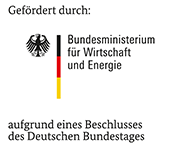
| Period: | 01.03.2010 - 31.08.2012 |
|---|---|
| Partner: | TZW Karlsruhe |
| Funder: | Arbeitsgemeinschaft industrieller Forschungsvereinigungen e.V. |
| Project Manager: | Stefanie Hild |
| Research Group: | Electrochemistry |
Aims
The consumption of pharmaceuticals in human and veterinary medicine has reached a high level, leading to a growing contamination of sanitary wastewater [1].
Because pharmaceuticals cannot be decomposed completely in conventional sewage plants [2] additional chemical and physical treatment is required.
Different approaches of wastewater treatment are examined. Electrochemical wastewater treatment with boron-doped-diamond-electrodes (BDD) is used as an alternative to chlorination [3, 4]. A further promising approach is the use of activated carbon that shows good adsorption capacities for many pharmaceuticals [5].
The aim of this project was to develop a new two-step process, in which the most promising treatment methods are combined.
In the first step pharmaceutical residues are accumulated by adsorption on activated carbon. In the second step the activated carbon is regenerated by electrochemical polarisation while the pharmaceuticals are desorbed. A BDD-electrode is used for the decomposition of the substances.
The advantages of this process are higher degradation rates of the pharmaceutical residues, a regeneration of the activated carbon and an economical batch process.
A technical adsorption/electrolysis cell to combine these two treatment steps was developed.
Results
The pharmaceuticals ibuprofen, carbamazepine, diclofenac, sulfamethoxazole and diatrizoate were chosen as model substances.
Carbamazepine, sulfamethoxazole and diatrizoate are not biodegradable, diclofenac is partially degradable. Ibuprofen is easily biodegradable and serves as reference.
All five substances can be detected and quantified via HPLC- and UV/Vis-analyses.
At first the electrochemical behaviour of the pharmaceuticals was examined and electrochemical parameters were determined.
Cyclovoltammetric measurements showed that all substances are electrochemically active on different electrode materials (platinised titanium, glassy carbon and BDD).
Degradation and product formation of all five substances were shown in spectroelectrochemical measurements. Degradation is an oxidative process in most cases, whereas the x-ray contrast agent diatrizoate is decomposed at positive and negative potentials.
Different electrode materials were used. In the case of stable compounds BDD-electrodes are necessary for a fast and complete degradation.
It was shown that a higher concentration of the pharmaceuticals causes an increased current efficiency.
The adsorption behaviour of the substances was examined. All five pharmaceuticals are easily adsorbed on activated carbon. Positive polarization of the carbon accelerates adsorption.
Negative polarization of the activated carbon causes desorption of the adsorbed substances. Those are subsequently decomposed on the positively charged counter electrode. Decomposition is increased with increasing potential. The use of BDD as electrode-material leads to increased decomposition and mineralization of the desorbed substances.
Measurements in a divided cell show that ibuprofen is desorbed undecomposed while diatrizoate is already decomposed inside the negatively charged activated carbon.
Uncharged molecules like sulfamethoxazole are desorbed during negative polarization as well.
A technical cell was built to combine adsorption and desorption. Successively adsorption in flow-through mode and desorption in a closed loop are carried out. A BDD-electrode is used as counter electrode.
Adsorption and subsequent desorption and decomposition of ibuprofen were shown in this cell.
Performance and stability of the system was examined in a small divided cell. Within one hour 65% oft he adsorbed substances were desorbed. Adsorption takes much longer and is therefore the rate-determining step.
After several adsorption-desorption-cycles no decrease in adsorption capacity was measured.
The iodinated x-ray contrast agent diatrizoate exhibits an interesting decomposition mechanism that was studied in detail. A stepwise reductive dehalogenation of the iodine atoms was shown.
Literature:
[1]: Th. Track, G. Kreysa (Hrsg.), Spurenstoffe in Gewässern, Wiley-VCH, Weinheim (2003) ISBN 3-527-31017-7
[2]: M. Salomon, UWSF-Z Umweltchem Ökotox, 2007, 19, 155
[3]: A. Kraft, M. Wünsche, M. Stadelmann, M. Blaschke, Special Industrie + Wasser, 2006, 9, 36.
[4]: I. Tröster, L. Schäfer, M. Fryda, New Diamond and Frontier Carbon Technology, 2002, 12, 89.
[5]: S. Metzger, H. Kapp, G. Hiller, W. Süßmuth, Umwelt Magazin, 2006, 9, 34
back
Das IGF-Vorhaben Nr. der Forschungsvereinigung DECHEMA e.V., Theodor-Heuss-Allee 25, 60486 Frankfurt am Main wurde über die AiF im Rahmen des Programms zur Förderung der industriellen Gemeinschaftsforschung (IGF) vom Bundesministerium für Wirtschaft und Energie aufgrund eines Beschlusses des Deutschen Bundestages gefördert.